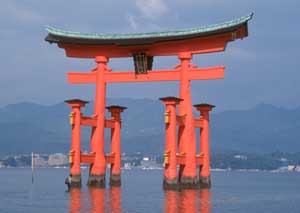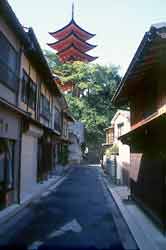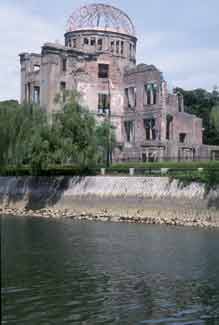Hiroshima Area
| Hiroshima City | Miyajima |

With Japan's excellent rail system I would not bother to fly domestic within Japan for many destinations. For example the trip from Kyoto to Hiroshima took about four hours. Its probably an hour flight but combine getting to the airport 2 hours before the flight with the airports been on the outskirts of the city and with train stations usually downtown, its much faster, cheaper and more convenient to take the train. The bullet train reaches speeds of 300 kph. Japan's main island Honshu is covered by a network of high speed train lines that connect Tokyo with most of the island's major cities and Fukuoka on the island of Kyushu. The Japan rail pass is one of the few travel bargains in the country.
Hiroshima City
|
Hiroshima is a port city that is more famous for what was done to it as oppose to what it did. On August 6, 1945 an atomic bomb was dropped on Hiroshima which destroyed almost every building within 2 kilometres of the epicentre and killed up to 140,000 which included POWs and Korean labourers.
A few buildings survived including the Industrial Hall which was near the epicentre. A few other buildings survived including a hospital and city hall which were refurbished and used until new structures were builted. The Industrial Hall which was renamed the Genbaku-Domu-mae or Atomic Dome was going to be torn down in the 1960's but some far-sighted citizens lobbied to maintain the building as a monument to the destructive forces of nuclear weapons. The Genbaku-Domu-mae is part of the Peace Memorial Park which includes many touching monuments and the Hiroshima Peace Memorial Museum. The museum has to be the greatest bargain in Japan. Most museums and treasure halls in Japan charge about ¥500 for admission give or take 100¥. Admission to the Peace Museum is ¥50. Its a very good museum which does not shy away from Japanese military history, Hiroshima's naval history, Korean labourers or the rape of Nanking. Today Hiroshima is the centre of the nuclear disarmament movement, the wall of letters that the various majors of the city have send to the leaders of countries every time a nuclear bomb is tested is impressive. One wing of the museum is a collection of A-bomb artifacts, remains of the destruction. Hiroshima is Japan's 5th largest city, more attractive than Osaka but still a modern Japanese city. It seems to have more museums than Osaka and also has its own reconstructed castle. Guess when the former castle was destroyed. Hiroshima castle is of a different style than the one in Osaka but after seeing the real castle in Himeji, I was not interested in seeing another reconstruction. The map of the city we obtained at the information booth at the train station indicated some castle ruins and ancient battlefields outside the city but I have no idea what they might be like, we were heading for Miyajima Island. |
Miyajima Island
Since ancient times, Miyajima has been regarded as one of the "Three Most Beautiful Spots" of Japan, and as a part of the Seto Inland Sea National Park, it has received several distinctions, such as a place of extraordinary scenic beauty, exceptional history, a scenic zone, and a natural monument.

There are several ways to get to the island from Hiroshima. A fast ferry leaves from Hiroshima port which takes about 23 minutes. The city tram and Japan Railways also go to Miyajima-guchi, from there it is a 10 minute ferry ride. If you have a Japan rail pass that ferry is free. Its a long tram ride from the city centre on the Miyajima line, about 45 minutes from Genbaku-Domu-mae.
You will see Miyajima most famous symbol from the ferry, the torii of Itsukushima Shrine. At high tide the entire shrine appears to be floating on water, at low tide its surrounded by mud flats. Along with
Himeji castle, the Otorii Gate is probably the symbol of Japanese tourism.

There are several ryokans including a people's ryokan called Miyajima Morinoyado. People's ryokans are government funded ryokans which are priced for the Japanese middle-class so that the average Japanese family can afford to stay at a fancy ryokan. Although geared toward the Japanese family (and publicly funded) foreigners are welcomed especially in the off-season. These public ryokans are often booked months in advance. And I mean fancy, we walked right by the ryokan thinking this can't be the place - its too nice.
Miyajima has been revered and worshipped since ancient times and along with Itsukushima Shrine there are plenty of other temples, shrines and pagodas on the island. Deer move around the island freely, and so do monkeys on top of Misen, the island's highest mountain. The deer on Miyajima are also considered sacred and will accept food from visitors. There are no cemeteries on the island, as part of its sacredness no body is allowed to be born or die on the island.
Miyajima is also a good place for natural landscapes since the island as been spared from clear-cutting and has much of its virgin forest intact. A large amount of southwestern Japan native botanical species can still be found on Miyajima.
Because of its proximity to Hiroshima most people visit Miyajima as a day-trip but its well worth spending the night if only for the peace and quiet. Once the last ferry leaves Miyajima gets very quiet. Itsukushima Shrine gets
lit-up at night.
| Visit the Kyoto |
Visit Kansai Area |
Return to Travel Page |
Return to Main Page |
